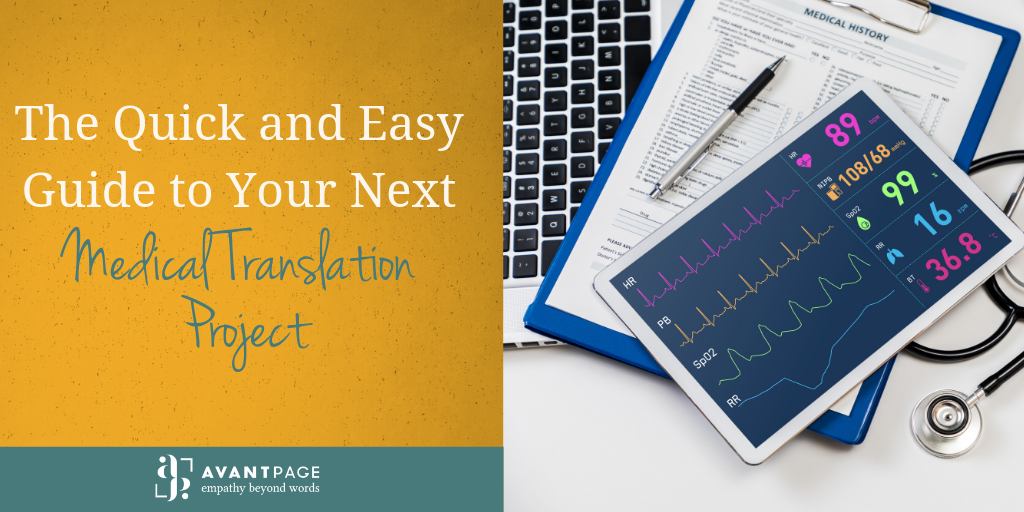Translation projects involve a lot of moving pieces. The more informed you are on the translation process and how it works before you begin your medical translation project, the more likely it is that your projects will be successful and that you’ll be able to take advantage of savings opportunities.
What Will A Medical Translation Project Typically Entail?
Once you’ve chosen a Language Service Provider (LSP) and met with your key contact, you’ll provide the documents that need to be translated. Before your medical translation project begins, you may be asked to provide a glossary of standard terms or common names. If you have an English glossary, your LSP can help to translate this into your target languages as a great first step to ensuring accuracy and consistency across documents. If you have never used a glossary, now is the time to ask your LSP about the steps you need to take to create a glossary and other linguistic assets like a style guide.
If you’re working with Avantpage, the next step is that we upload your original text into the translation management system, which breaks it up into segments. Our native-speaking linguistic team then translates and edits each text segment, and their work is saved in what we call a Translation Memory (TM). Your TM provides savings on your medical translation projects over time and can shorten the turnaround times on your translations.
The actual process of translation is straightforward: the documents you send as part of your medical translation project will be translated by one of our certified linguists. Once the initial translation is complete, the translation will be seen by a different linguist who will edit the translation to ensure the accuracy of the translated work. Finally, your document will be sent to one of our proofreaders who will review the target text and ensure it matches the original message, tone, and is compliant with your style guide and glossary.
Dependent on your organization’s goals with the medical translation project, you may require additional services. These can include:
- Desktop Publishing (DTP): Re-creating foreign language page design and layouts both for print and web use, without compromising the message and feel of the original material.
- Website Localization: Ensures your website performs as if it were produced in the target language.
- Linguistic Asset Management: Create, manage and deploy your linguistic assets such as translation memories, style guides, and glossaries.
- Software Localization: Ensures your software functions properly in all target languages
How Much Will A Medical Translation Project Cost?
Written translation is most commonly charged by the word. The rate for your medical translation project will vary based on word count, complexity, and scope.
The source language word count is generally used as a basis for the translation because the target language may differ in word count and space dependent on a variety of factors. The target language may be longer or more compact than your source language. For example, text in Spanish can take up 20% more space than the same text in English.
Other elements that can increase or decrease the price of your medical translation project include language combination, formatting needs, urgency, and complexity. If you want to keep the costs of your medical translation project low, be sure to send the documents with plenty of time for translation and discuss your needs and your budget with your LSP.
How Long Will A Medical Translation Project Take?
Like rates, the time a medical translation project takes depends on the project itself. A larger, more complex project will take longer than a simple one. Additional time is required for text that requires heavy formatting (DTP – Desktop Publishing) after translation. The time it takes to complete a medical translation project is heavily dependent on the length and complexity of your document.
For projects of all sizes, you can ensure quick and efficient completion by compiling all the documents and data your LSP will need in advance. You should also be sure to send your documents in an editable format so your LSP won’t have to recreate them prior to beginning the translation. The more organized you can be, the more quickly the process will go.
Each medical translation project is different, with varying timelines, costs, and needs. We can help you start your next medical translation project. Give us a call at 530-750-2040 or request a free quote today.
GET VALUABLE CONTENT DELIVERED STRAIGHT TO YOUR INBOX. SIGN UP FOR OUR NEWSLETTER TODAY!

Ash is the Marketing Coordinator at Avantpage, Inc. Ash works to create high-value, targeted content that allows consumers to connect with us at Avantpage. They are a strong proponent of everyone having equal access to communication and information. They have written and created content for a variety of online platforms, and have been published in over 30 online platforms with varying topics. But Ash is other things too! An avid athlete, Ash enjoys spending their free time rock climbing, partaking in aerial circus sports, and practicing acroyoga.
